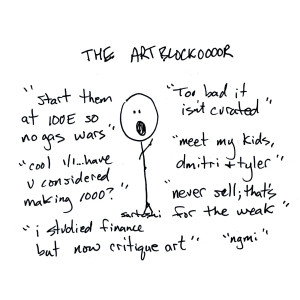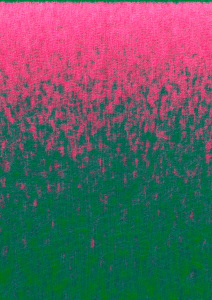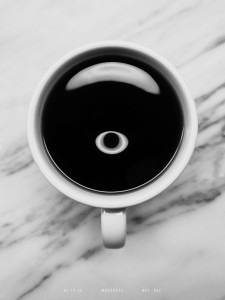Spalter Digital
A significant collection of computer-generated art on paper has expanded its holdings to include NFTs.

Things move quickly in the crypto space, and it’s possible to become an important figure in a short span of time if you have the right combination of drive, luck, and taste. Josh Yakov’s story is a prime example. He knew relatively little about crypto or art before the pandemic, but he’s now a respected collector and works with Sofia Garcia at ArtXCode, a generative art house that produces creative coding projects, represents artists, and provides services for collectors. Below he shares the story of how he amassed an NFT collection numbering in the thousands on Tezos and Ethereum, how he organizes the works, and his views on the debates around the “on-chain” status of generative art NFTs.

Growing up in New York, I always had an appreciation for art, but never really dove into it. I studied business in school but ended up going into cooking. I was working at a restaurant upstate until I lost my job because of the pandemic. That’s when I went down the crypto rabbit hole. I got into defi for a bit, then discovered NFTs.

I got lucky: my first NFT was a CryptoPunk, which led me to research other collectibles. But I always had an eye on more art-focused platforms, like Foundation and SuperRare. Art Blocks opened up art even more. It was very affordable in the early days. What excited me most about these platforms was their elegant UI and their approachability. I grew up on the Upper East Side, near fancy galleries that always felt snooty. The NFT space was different. I’ve always been a math person, so I liked studying rarities and other data structures in generative art as an alternative to the traditional criteria of aesthetic judgment. When I was a kid I’d look at baseball cards, or statistics, and pay attention to the things that stuck out. Generative art mirrored that in a really beautiful way.
I try to zig when other people zag. After the Art Blocks craze of summer 2021 I found the Tezos scene to be really refreshing. I became active on FxHash, which is known as an open generative art platform with decentralized curation. There is a lot of contention around FxHash being an off-chain generative art platform, as opposed to Art Blocks, which is considered on-chain. But I think the debate needs more nuance. Organizations like ClubNFT and curator Regina Harsanyi have been instrumental in educating the wider community on some of these questions. The browsers that render the work are not on-chain, and we don’t know whether they will continue to be able to render the codebase libraries that generative artists use. FxHash has fewer limitations than Art Blocks in terms of which libraries and code languages artists can use. There are projects on Art Blocks that use oracles, which are not built-in functionalities of the blockchain. The on-chain narrative is an important conceptual aspect of blockchain art. But I don’t think the blockchain is conceptually important for every single Art Blocks piece.

I had brushed off Tezos in the beginning. I wasn’t fully convinced by the “green” narrative. I agree that there are environmental issues that we need to solve as a society, but that’s not the only reason why I collect art or believe in something. But there’s a grassroots movement on Tezos that has brought innovation, experimentation, and excellence. Work minted on Tezos is usually less expensive than the same artist’s work on Ethereum. I’m blockchain agnostic and would rather seek out the best value.
It took me some time to change from a flipper’s mindset to that of someone who really values what the artists are doing. There’s a 2021 piece by Sartoshi called artblockoooor,mocking Art Blocks collectors, that still resonates today. Sartoshi was a legendary maker of memes, though a little controversial because of the way they disappeared last June. I think shitposting is an art, and Sartoshi did it in a way that revealed some truths about the space. Groupthink often becomes the reason why something has value. It’s important to think for yourself. Die With the Most Likes makes art from a similar place. He gives no fucks. He just tells a story of his life in Indiana and what’s around him. He pokes fun at the consumerism and conformism we’re bombarded with on social media. He’s one of the funniest people I’ve met. Lorna Mills, 0x3y3, and Xer0x are other artists who rock to the beat of their own drum. I love and collect their work as well.

Iskra Velitchkova is an incredible artist from Bulgaria, and I happen to be of Bulgarian descent. Roses are one of Bulgaria’s biggest exports. Iskra’s work Dolina i (2022) represents a Bulgarian rose valley. I found this piece because Itzel Yard was sharing it, and it reminds me of the importance of artists sharing other artists’ work. I also have Organized Glitch .::….: (2022) by Itzel, and the title describes how I operate. I’m kind of glitchy. I’m all over the place. This work is about the beauty in the randomness that goes on in life. Iskra and Itzel have both been vocal about the discrepancies in what people of different genders earn in this space. That won’t change if people don’t act with intentionality.
I’m quite fond of Andreas Gysin’s “svg.svg series” (2021–22). It shows the scalable vector graphics interface from a coder’s point of view, and the ASCII art transforms—it looks like both a script and the art that’s generated from it. It shows the canvas of generative art in an especially artistic way. I think it’s brilliant. Gysin makes work under the pseudonym ertdfgcvb, a set of letters that sit together on the keyboard. Maybe it’s alluding to how his work is grid-like but in motion.

The artist known on Tezos as Caesuras recently revealed himself as Casey Reas. In my humble opinion Caesuras’s works are some of the most important generative art pieces ever. The subtle detail makes it look like a motherboard (especially the “CAAI” series). Casey’s contribution to creative code art and the play with web3 pseudonymity are culturally significant as well. There’s an interview with Micol of Vertical Crypto Art where Casey talks about how Hic et Nunc, the first NFT marketplace on Tezos, reminded him of the early days of Processing, the creative coding software he helped develop, when all these fragmented, decentralized communities were working in their own little niches, but were still connected to one another.
I started different wallets on Tezos because I had thousands of NFTs and I needed a sorting system. The pieces in my Monochromatic wallet are black-and-white, and the ones in Variegated have a range of colors across the spectrum. The pieces in these accounts are just as important to me as the ones in my Archived collection. Monochromatic has Slave Ship Diagram (2022) by Auriea Harvey, William Mapan’s genesis piece, and a token from Monogrid by Kim Asendorf, one of the best generative art collections that exist. There are also some “Mugshots” by Gary Edward Blum. A lot of NFT culture is just people saying “GM” all the time. The coffee cups in “Mugshots” are part of a ritual that many of us go through every day. Those little things bring you joy. As a cook I know that the best dish isn’t one with fifty ingredients, but one with three ingredients done right. The “Mugshots” look simple from the outside, but there’s a lot of nuance there.
—As told to Brian Droitcour
